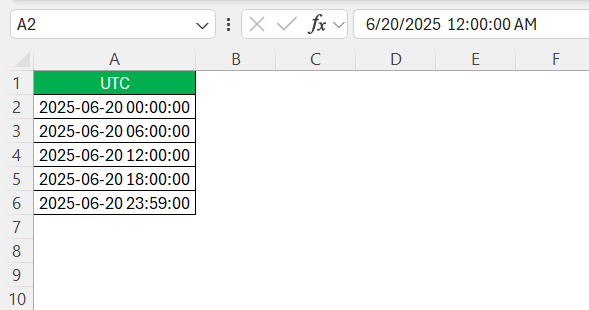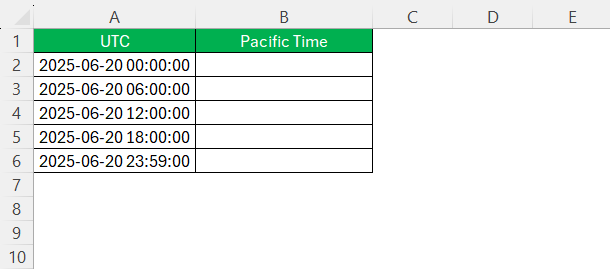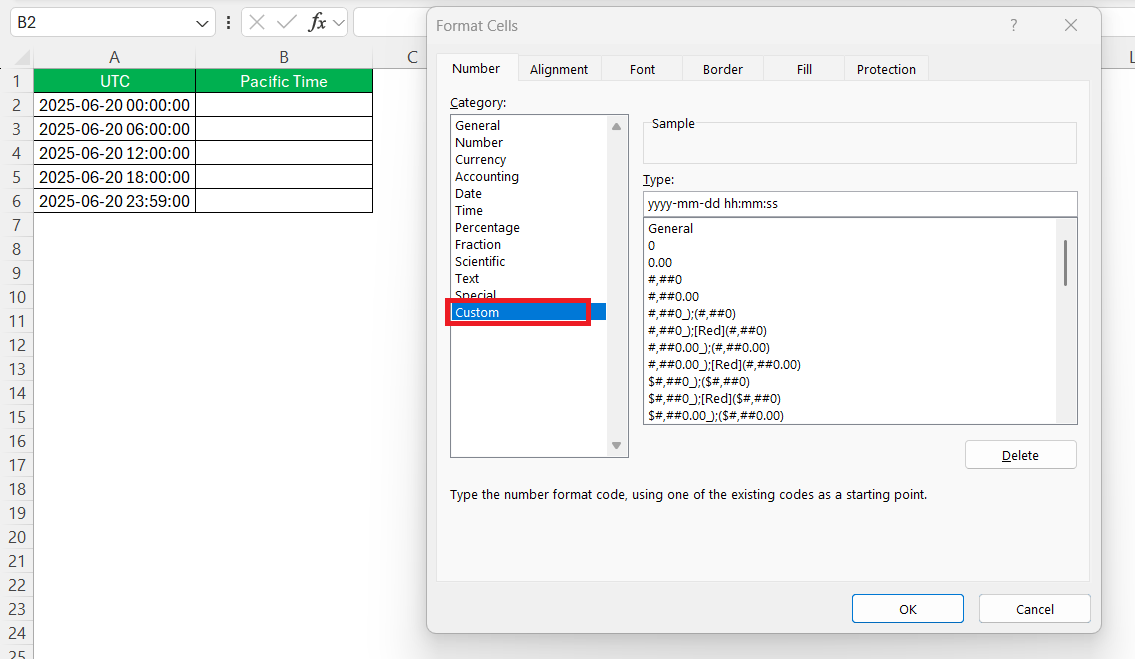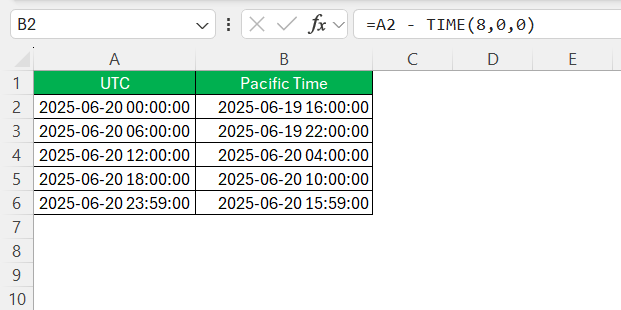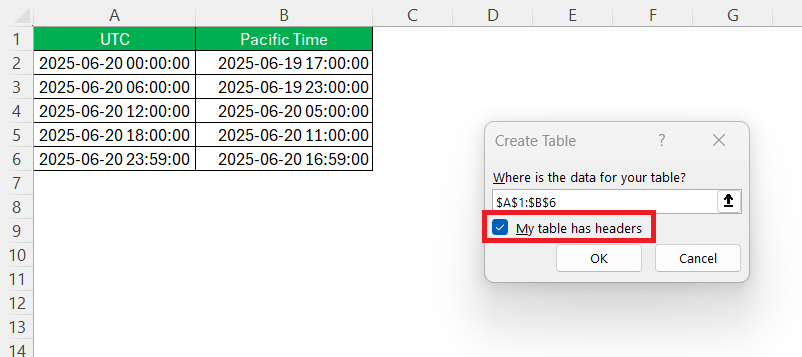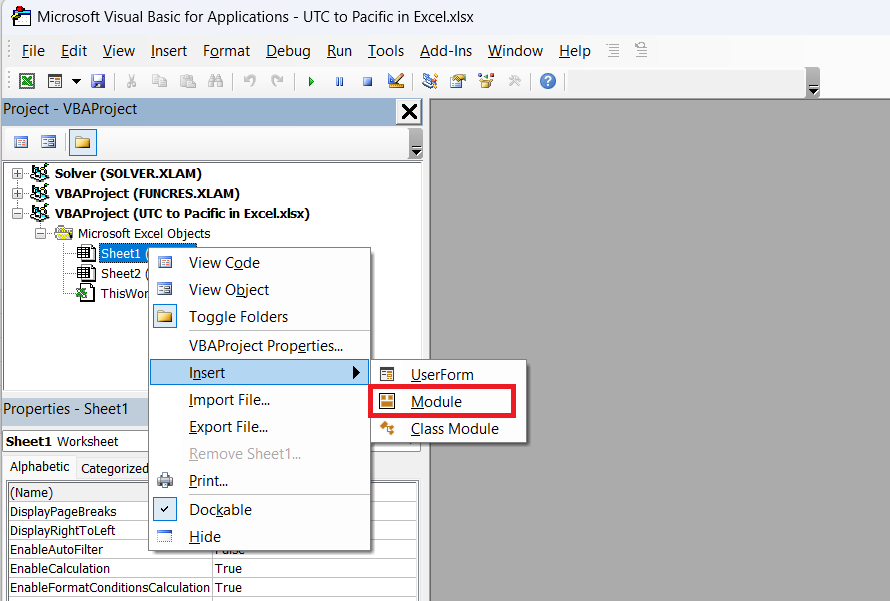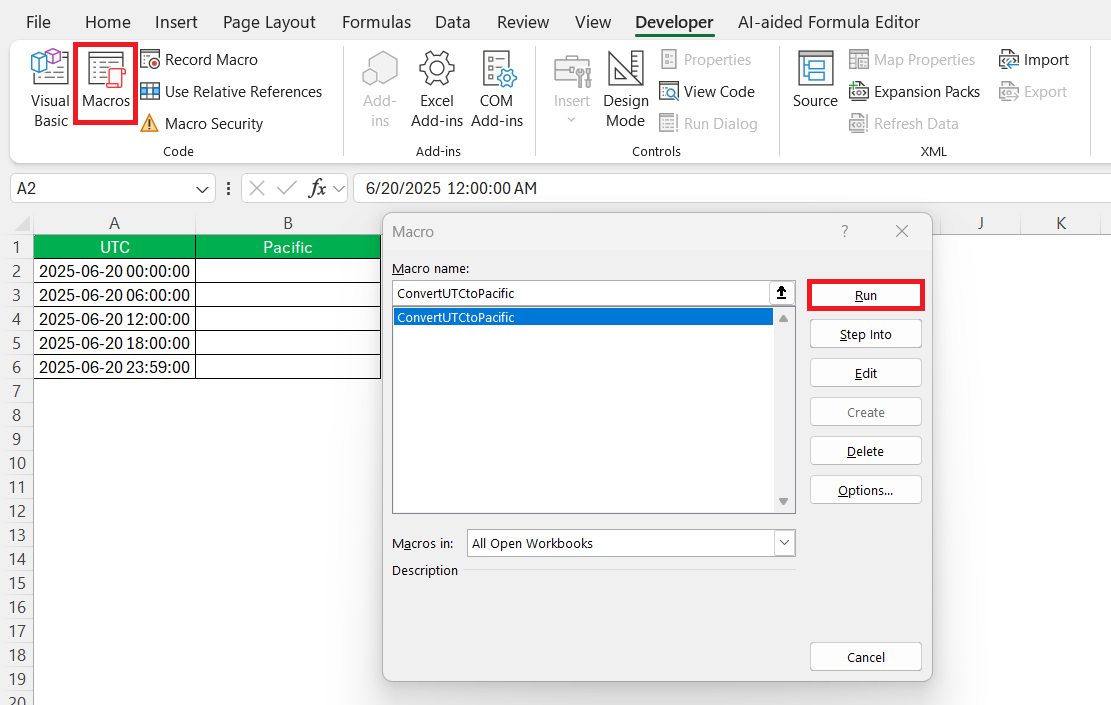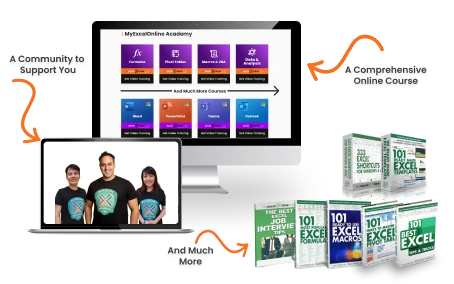If you’ve ever found yourself staring at a spreadsheet filled with UTC timestamps and thinking, “Why can’t this just display Pacific Time?”—you’re not alone. Whether managing server logs, organizing international meetings, or analyzing time-based data, converting UTC to Pacific Time in Excel can initially appear straightforward, yet often proves unexpectedly complex.
In this guide, I will walk through the step-by-step process I followed to achieve accurate and efficient UTC to Pacific Time conversions using Excel.
Key Takeaways:
- UTC doesn’t change, but Pacific Time shifts between UTC-8 (Standard) and UTC-7 (Daylight Saving Time).
- A simple =A2 – TIME(8,0,0) formula subtracts 8 hours for basic conversion.
- Use IF and AND logic to dynamically adjust for Daylight Saving Time.
- VBA macros or Excel Tables help automate conversions for large datasets.
- From meetings to analytics, getting time zones right prevents miscommunication and drives smarter outcomes.
Table of Contents
Introduction
Understanding UTC and Pacific Time
Coordinated Universal Time (UTC) is the standard reference for timekeeping worldwide. It’s not influenced by time zones or daylight-saving time adjustments, making it a precise measure for time-based calculations. Conversely, Pacific Time (PT) varies depending on the season.
Standard Time is UTC-8, while Daylight Saving Time, observed from the second Sunday in March to the first Sunday in November, shifts it to UTC-7. Understanding these differences is crucial for accurate time zone conversions in Excel, especially when working with international data.
Why Converting Time Zones in Excel is Essential
Converting time zones in Excel is paramount for several reasons. With global business operations becoming the norm, it’s crucial to ensure effective communication and coordination across different regions. When managing tasks like scheduling meetings, tracking deadlines, or analyzing international data trends, precise time zone conversions ensure all participants are on the same page.
Moreover, errors in time conversion can lead to missed deadlines or miscommunication, potentially impacting business outcomes. By mastering these conversions in Excel, we streamline processes, improve efficiency, and maintain a cohesive flow of operations globally.
Step-by-Step Guide to Convert UTC to Pacific Time
Setting Up Your Excel Spreadsheet for Time Zone Conversion
Setting up your Excel spreadsheet for time zone conversion starts with organizing your data correctly. Begin by entering your UTC dates and times in one column.
Create a new column labeled “Pacific Time” to hold the converted values.
Next, ensure that Excel recognizes your time entries as valid date and time formats. You can do this by selecting the cells and applying a consistent format by navigating to the “Format Cells” option, choosing “Custom,” and specifying a format like “yyyy-mm-dd hh:mm:ss” for ease of use.
This setup will facilitate efficient and accurate time zone conversion when you apply formulas or other methods.
Time Formula to Convert UTC to Pacific
For a quick-and-dirty conversion that ignores DST:
=A2 – TIME(8,0,0)
Here, I’m assuming cell A2 contains the UTC timestamp. This subtracts 8 hours from UTC. Boom—basic Pacific Time.
But what if I want Excel to figure out whether it’s Daylight or Standard Time based on the date? Let’s get into the fun part.
Creating a Formula to Account for Daylight Saving
To create a formula that accounts for Daylight Saving Time (DST) when converting UTC to Pacific Time, you must determine the correct offset. Pacific Time shifts between UTC-8 during Standard Time and UTC-7 during DST. To automate this shift in Excel, use the IF function in conjunction with the AND function to decide the correct time offset based on the date.
Start by writing a formula that checks if the date falls within the DST period. Here’s a basic template for your formula:
=A2 – IF(AND(A2>=DATE(YEAR(A2),3,8)-WEEKDAY(DATE(YEAR(A2),3,1)),A2), TIME(7,0,0), TIME(8,0,0))
This formula checks if the date in cell A2 falls in the period where DST is active.
- It checks if the date is between the second Sunday of March and the first Sunday of November.
- If yes, it subtracts 7 hours (DST).
- If no, it subtracts 8 hours (Standard Time).
You can enhance the formula by including more sophisticated checks using Excel’s WEEKDAY function for the specific Sundays or by referencing a table with specific DST start and end dates. This approach allows the formula to be flexible and responsive to yearly changes in DST schedules, ensuring your Pacific Time conversions are always accurate.
Advanced Techniques for Time Conversion
Automating the Process for Multiple Entries
To automate the conversion of multiple UTC entries to Pacific Time in Excel, leverage the fill handle or use array formulas for bulk operations. Begin by applying the daylight saving formula to the first row of your data, ensuring it correctly adjusts for either Standard Time or Daylight Saving Time. Once the formula is tested and accurate, use the fill handle—click and drag the small square at the bottom-right corner of the cell containing the formula—to extend it down the entire column alongside your UTC data.
For even more efficiency, especially with larger datasets, consider using Excel’s Table feature. Converting your data range into a table allows for automatic formula propagation to new data entries, thus minimizing manual effort. Simply select your range, navigate to the “Insert” tab, and click on “Table.”
Ensure “My table has headers” is checked to maintain clarity.
This tool is particularly useful when dealing with datasets that have conditional requirements or when summarizing data across different time zones. These strategies help you streamline your workflow, saving time and reducing the potential for errors.
Using VBA Macros for Automation
VBA (Visual Basic for Applications) macros offer a powerful way to automate time zone conversions in Excel, providing versatility and efficiency for handling large datasets. By writing a VBA script, you can encode specific conversion rules, including adjustments for Daylight Saving Time, and apply them to your data seamlessly.
To begin, access the VBA editor by pressing ALT + F11, and in the VBA interface, insert a new module by right-clicking on the project pane.
Here, you’ll write a macro that collects UTC time data, applies the necessary calculations based on the date (checking for DST), and outputs the Pacific Time.
Here’s a simple script structure:
Sub ConvertUTCtoPacific() Dim rng As Range For Each rng In Selection If IsDate(rng.Value) Then If Month(rng.Value) > 3 And Month(rng.Value) < 11 Then rng.Offset(0, 1).Value = rng.Value - TimeSerial(7, 0, 0) Else rng.Offset(0, 1).Value = rng.Value - TimeSerial(8, 0, 0) End If End If Next rng End Sub
This macro iterates through a selected range, checks if each value is a date, and then subtracts the appropriate number of hours based on whether it’s within the Daylight Saving Time period or not. You can enhance this script to include error handling, dynamic range selection, and logging of conversions for a more robust solution.
Once your VBA macro is fine-tuned, you can run it to automate the conversion process with a single click, significantly reducing manual effort and minimizing the risk of errors.
This approach is especially beneficial when dealing with large datasets or repetitive conversion tasks.
Real-World Applications of Time Zone Conversion
Scheduling International Meetings Efficiently
Scheduling international meetings can be complex due to varying time zones, but Excel can simplify this task through its time conversion capabilities. By accurately converting UTC to various local times, we can ensure each participant joins at the correct time, avoiding confusion and miscommunication.
Start by listing all participants’ local times in a spreadsheet, using time conversion formulas to adjust from UTC. Organize the data with columns for participant names, locations, UTC time, and converted local times. This setup offers a clear view of when each participant will meet.
For recurring meetings, automation can further simplify scheduling. Use Excel’s calendar or scheduling templates to visualize time slots, noting any discrepancies caused by Daylight Saving Time changes. Complement this with conditionally formatted alerts to highlight conflicts or unsuitable times.
Finally, share this schedule with meeting attendees through integrated tools, such as exporting schedules to Outlook or Google Calendar. This integrated approach ensures seamless communication and coordination, leading to more efficient and productive international meetings.
Tracking and Analyzing Global Data Trends
Tracking and analyzing global data trends efficiently requires an accurate understanding of time zones and time conversions, which play a crucial role when data is timestamped differently across various regions. Excel provides powerful tools that allow us to standardize these timestamps, facilitating comprehensive analysis and enhancing the insights drawn from data.
First, compile your global datasets and ensure that all timestamps are converted to a common standard, such as UTC, using Excel’s formula functions. Once unified, you can efficiently compare data points from various time zones on an equal footing, allowing for compelling trend analysis and accurate measurement of metrics.
Utilize Excel’s pivot tables to summarize and examine data patterns over time, highlighting trends that may vary by region. This function is pivotal in dissecting global data and pinpointing anomalies or abrupt changes that require further investigation.
Incorporate visualizations like charts and graphs for clearer data interpretation. These tools further our understanding of the temporal distribution of trends, revealing peak activity times globally and any correlation with local events or business cycles.
For more advanced needs, link your Excel data with external analytical tools through add-ins or Power Query integrations, enabling more sophisticated data modeling and predictive analytics. This enhances our capacity to forecast future trends and make informed strategic decisions. By maintaining a standardized approach to time conversion and leveraging Excel’s analytical features, we can effectively track and analyze global data trends with precision and clarity. This ensures that we remain agile and responsive to the dynamic nature of international markets and operations.
FAQs
What’s the easiest way to convert UTC to Pacific Time?
The easiest method is to subtract 8 hours using =A2 – TIME(8,0,0), assuming A2 contains a valid UTC datetime. This works year-round if you’re okay with always using Standard Time. However, it doesn’t account for the real-world shift to UTC-7 during Daylight Saving. For projects that need precision, it’s better to factor in DST.
Why do I need to convert UTC to Pacific Time in Excel?
Many global systems log events in UTC, making it essential to convert to local time zones for clarity, especially when collaborating across regions. In the Pacific Time zone, this ensures meetings, reports, and deadlines are correctly aligned with local expectations. Excel offers a fast, repeatable way to do this without needing separate software. It’s especially helpful when managing calendar data, scheduling, or coordinating time-sensitive workflows.
What formula should I use to convert UTC to Pacific Time in Excel?
To convert UTC to Pacific Time in Excel, use the formula =A2 - TIME(8,0,0). This subtracts 8 hours from your UTC time in cell A2 for PST. For Daylight Saving Time (PDT), use =A2 - TIME(7,0,0) to subtract 7 hours. Remember to adjust the formula seasonally between these two time shifts.
How can I adjust for Daylight Savings automatically?
To adjust for Daylight Saving Time automatically in Excel, use a formula incorporating the IF function to check dates. For example: =A2 – IF(AND(A2>=DATE(YEAR(A2),3,8)-WEEKDAY(DATE(YEAR(A2),3,1)),A2. Modify this logic to fit specific DST rules.
Can I automate time zone conversions for a full column of timestamps?
Yes, and it’s easier than you might think. Apply your formula to the first row, then drag it down using Excel’s fill handle to apply it to all rows. If you’re working with dynamic datasets, convert your data into an Excel Table so formulas auto-apply to new rows. For more advanced automation, use VBA macros to process entire ranges with a single command.
John Michaloudis is a former accountant and finance analyst at General Electric, a Microsoft MVP since 2020, an Amazon #1 bestselling author of 4 Microsoft Excel books and teacher of Microsoft Excel & Office over at his flagship MyExcelOnline Academy Online Course.

